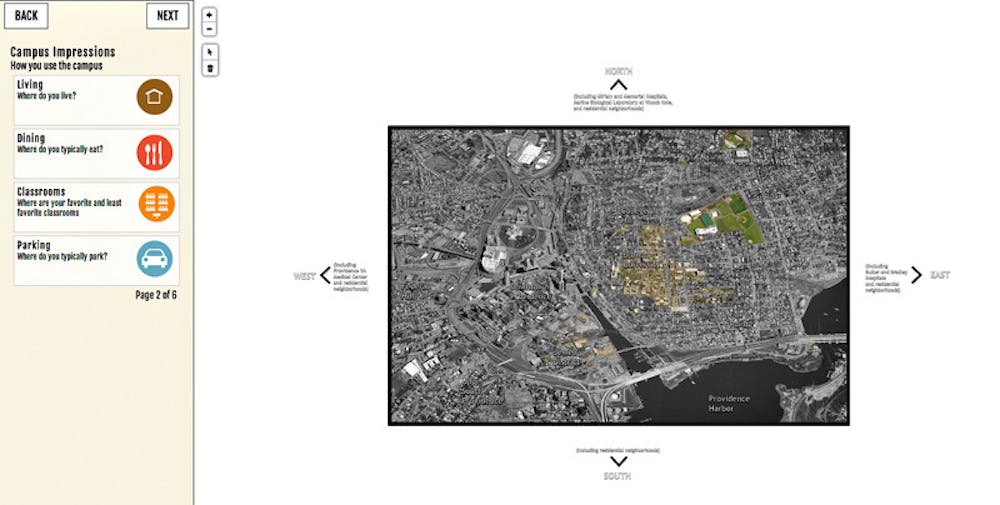President Christina Paxson invited all students, staff members and faculty members last Wednesday to participate in the MyCampus survey prepared by design firm Sasaki Associates. The survey marks a key component of data collection for the Committee on Reimagining the Brown Campus and Community, one of the six strategic planning committees.
MyCampus gathered over 1,400 responses from community members as of Tuesday.
“MyCampus is like nothing we’ve done before,” said Russell Carey, executive vice president for planning and policy and chair of the committee.
An interactive map of the University campus, the MyCampus survey asks community members to tag where they spend their time doing things such as eating, sleeping, studying and socializing. The committee will use the data to inform plans for both long-term campus design and the resolution of small-scale navigation and safety concerns around campus such as lighting conditions and signage. So far, community members have dropped icons on locations all around the main campus as well as the Jewelry District, underscoring the University’s presence in the latter location.
The map interface of MyCampus facilitates the firm’s dynamic understanding of how people use the campus, said Tyler Patrick, principal of Sasaki Associates. MyCampus represents the third survey conducted by Sasaki in the planning process, following two faculty surveys about infrastructure and areas of collaboration.
“We’re helping the University develop framework planning, which is the physical manifestation of the strategic plan,” Patrick said.
Sasaki will work with Brown through July to develop that framework, approaching planning by looking at the integration of the academic and financial needs of the University, Patrick said. The firm examined both current real estate opportunities and places for future growth — on College Hill and in the Jewelry District — in its collaboration with the University, Patrick said.
These findings will be submitted to the Corporation in May and will be used to dictate the prioritization and funding of proposals that come out of the survey results, Carey said.
Before the release of MyCampus at the University, complaints about the campus had been directed to the Office of Student and Employee Accessibility Services.
MyCampus and other work done through the committee build upon parts of the Plan for Academic Enrichment enacted during former President Ruth Simmons’ tenure.
“What we’re doing right now is building on a very strong foundation of the last 10 or so years: the Strategic Framework for Physical Planning,” Carey said. “When you build on a strong foundation, it’s useful to assess yourself and look carefully with a fresh pair of eyes.”
Though MyCampus does not collect any input from short-term or occasional visitors, the committee has received feedback from faculty members about these visitors and the ease with which they navigate and park around the campus, Carey said.
Though it has no formal deadline, MyCampus will stay open for another couple weeks. The current participation rates at Brown have been among the highest Sasaki has seen for MyCampus, Patrick said. He cited the engagement of the student body and the emails sent by senior administrators as reasons for this participation.
“We’re already pleased with the 1,400 responses,” Carey said. “That’s terrific.”
“Everyone we’ve talked to appreciates being able to give their feedback in this way and to feel like they’re a part of the process and being heard,” Patrick said. “Sometimes it confirms things we’ve already discovered or it reveals new patterns that only people who use the campus every day would know.”
Although competitors of Sasaki have launched tools with similar capabilities, MyCampus is “fairly unique to Sasaki,” Patrick noted. “Other versions don’t quite do what our tool does,” he said, adding that Sasaki’s program is more comprehensive than others.
Sasaki developed MyCampus two years ago. The tool emerged from the firm’s need to have a participatory planning process, Patrick said. To achieve the same input MyCampus now collects, Sasaki previously held open forums with faculty and staff members of other universities but only had limited success.
“Open forums are great for sharing information, but they are not the best way to collect information. Not everyone feels comfortable speaking up and there is never enough time,” Patrick said. “MyCampus allows us to hear honest feedback from more users.”
MyCampus has been used “very successfully” in the past at several other universities including Colgate University, the University of Texas at Austin and the University of Kentucky, Patrick said.
MyCampus has been generally well-received by students who have participated in the survey thus far.
“I thought the survey was surprisingly interactive and a lot of fun to do,” said Paige Morris ’16. “It was an interesting way to look at the campus and see exactly where all the time in my day goes.”
“I liked the formatting, and I thought the questions were direct and appropriate,” said Frank Goodman ’16.
The data collected through MyCampus is specifically intended for the strategic planning process and will likely have a lifespan of five to 10 years, Carey said. But “during that time frame, it’s a living document.”

ADVERTISEMENT




